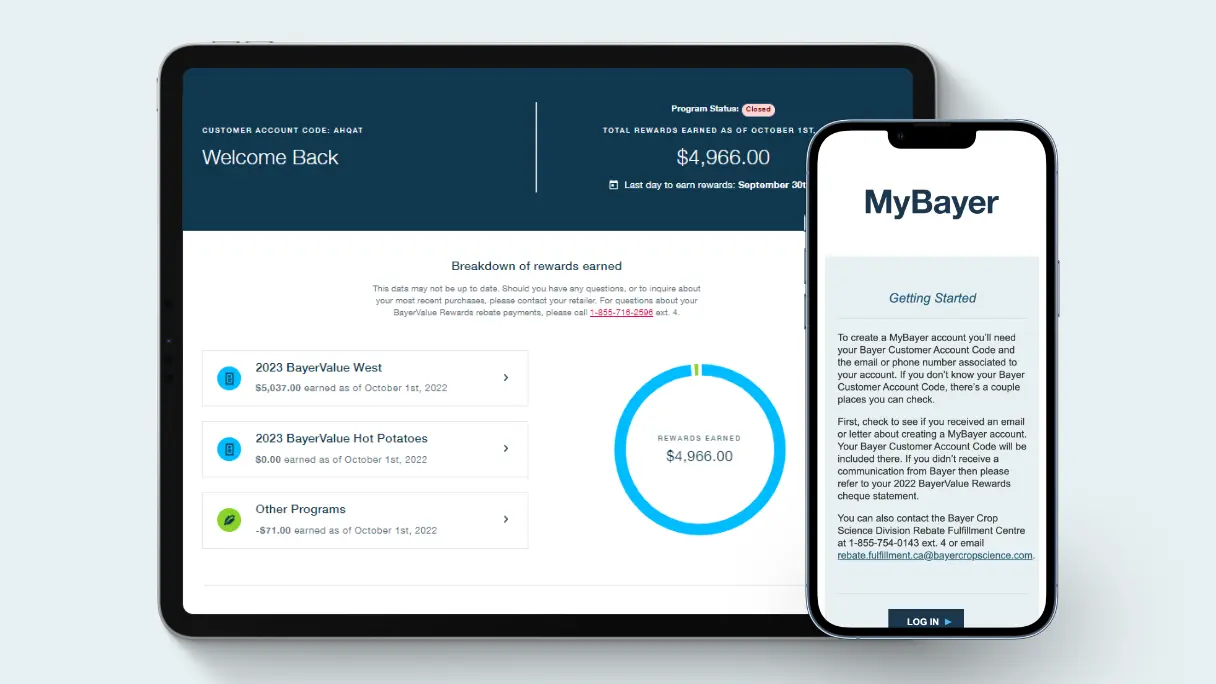5 READ-TIME
Herbicide decisions in TruFlex™ canola with Roundup Ready® and LibertyLink® Technologies
June 7, 2021

After completing a pre burn with a tank mix partner, these are questions to ask yourself next (in priority order):
Canola Growth Stage
Can I apply my first in-crop herbicide from emergence to two-leaf stage?
Yield loss from weed competition is highest in canola when weeds are emerging prior to the two-leaf stage.1 Weeds are likely to be smaller and easier to control early in the season. If possible, plan to do a first pass of in-crop herbicide between the cotyledon and two-leaf stage to help maximize yield potential. This also allows the opportunity to follow-up with a second in-crop application to control flushing weeds and perennials before the canopy closes.
Environment or timing has prevented a herbicide application between canola emergence and the two-leaf stage, what options do I have for weed control?
For TruFlex™ canola with Roundup Ready® and LibertyLink® Technologies, there are a few options.
- A total of 1.33L/acre of Roundup WeatherMAX® with Transorb® II Technology or Roundup Transorb® HC herbicide may be applied in-crop. Application may be split into two applications at 0.67L/acre with the final application made prior to first-flower.
- A single application of Roundup® herbicide at 1.33L/acre can be used up to the six-leaf stage of canola.
- Liberty® 150 SN herbicide may also be used with this canola seed technology prior to the bolting stage at rates up to 1.6L/acre. This application may be made a maximum of three times per year and the final application must be made prior to early bolting.2
- Full rates of Roundup® herbicide and Liberty® 150 SN herbicide may be used within the same growing season. For example, apply Roundup® herbicide at 1.33L/acre followed by Liberty®150 SN herbicide at 1.6L/acre.
Weed control is similar with either of the first two options. Roundup® herbicides at these rates control wild buckwheat beyond the 3-leaf stage and provide season-long control of dandelion. Greater consistency of control is seen on cleavers and foxtail barley at these rates compared to rates registered for use in original Roundup Ready® canola.3,4 Read the label available at https://www.cropscience.bayer.ca/Products/Herbicides/Roundup for full details on weeds controlled.
To determine if a single or sequential application should be made, consider the growing conditions and crop staging. Sequential applications of Roundup® herbicide should be at least 10 to 14 days apart. What stage will the canola be at in 14 days? Will it be possible to apply a sequential application before the crop begins flowering? If not, the full single rate may be the best option.
Environmental Conditions
Do the current weather conditions work for both chemistries?
Early in the season or when rain is forecasted, Roundup® herbicide may be the best option. Roundup® herbicide may be applied in cool conditions. Ensure that the temperature is forecasted to reach at least 8oC and will not drop below that temperature for at least two hours after the time of application.
Overall product performance of Roundup® herbicide is not affected by cloud cover. Symptoms may take longer to appear when Roundup® herbicide is applied on cloudy days.
Roundup WeatherMAX® herbicide has a 30-minute rainfast guarantee. Roundup Transorb® HC herbicide has a 60-minute rainfast guarantee with Bayer’s RiskShield® protection package.
For Roundup® herbicide and for Liberty® 150SN herbicide, weeds should be actively growing. In cases of severe frost or drought, wait until the weeds begin growing before applying these herbicides.
Weed Type
What are the weeds that are going to give me the most trouble and which herbicide makes sense at this time?
Roundup® and Liberty® 150SN herbicides are non-selective and effective at controlling many weeds. Roundup® herbicide is especially strong on grasses and perennial weeds. Listed below are some of the most prevalent weeds in the Prairies and the recommended herbicide.
Table 1. Prevalent weeds on the Prairies and herbicide recommendation in TruFlex™ canola with Roundup Ready® and LibertyLink® technologies.
| Weed | Recommended herbicide (Roundup® herbicide or Liberty® 150 SN herbicide) |
|---|---|
| Barnyard grass | Roundup® herbicide |
| Canada thistle | Roundup® herbicide |
| Chickweed | Liberty® 150 SN or Roundup® herbicide |
| Green foxtail | Roundup® herbicide |
| Lambsquarters | Liberty® 150 SN or Roundup® herbicide |
| Volunteer canola | Pre burn with tank-mix partner, control in rotational crops |
| Wild buckwheat | Roundup® herbicide |
| Wild oats | Roundup® herbicide |
How can I manage herbicide resistance?
Starting with a pre burn tank-mix is important to help manage herbicide resistance. This is an opportunity to apply multiple effective modes of action to weeds early. In TruFlex™ canola with Roundup Ready® and LibertyLink® technologies, Roundup® herbicide (Group 9) and Liberty® herbicide (Group 10) are two non-selective herbicides in different herbicide groups that can be used in-crop to help manage herbicide resistance.
Many of the most problematic weeds in Western Canada have herbicide resistance. The most common resistance identified in these weeds is to herbicides in Group 2.7 Having the option to use Roundup® herbicide and Liberty® 150 SN herbicide in canola can help control these weeds while reducing selection pressure on either herbicide.
In wild oats, biotypes with resistance to herbicides in Group 1, Group 2, Group 8, Group 25 and two-, three-, and four-way resistance have been found across Western Canada. In Manitoba, resistance to Group 14 and Group 15 herbicides has also been identified.7 For two effective modes of action against wild oats, Roundup® herbicide and Liberty® 150 SN herbicide can be used sequentially in-crop with this canola trait. Liberty® 150 SN herbicide works best when wild oats are between the one-leaf to four-leaf stage with a maximum of two tillers.4 For control of weeds beyond this stage it may be necessary to use Roundup® herbicide for the second in-crop application.
Liberty® 150 SN herbicide is effective on kochia prior to kochia reaching 8 centimetres (3 inches) in height.4 This can be a good option for management of glyphosate-resistant biotypes. It is recommended to wait 10 to 14 days after an application of Roundup® herbicide before applying Liberty® 150 SN herbicide. It may be necessary to apply Liberty® 150 SN herbicide as the first in-crop application to ensure an effective mode of action is applied to kochia while the weed is small enough for good control.
Roundup® herbicide can help control cleavers in canola where resistance to a Group 4 herbicide has been identified.
For more information on managing herbicide resistance visit https://www.mixitup.ca.
Planting TruFlex™ canola with Roundup Ready® and LibertyLink® Technologies can help provide more options for a herbicide program and allow quick adjustments as needed. Once the questions have been considered, logistics and other operational demands might come into the final decision.
Ultimately, the question we need to ask is: How can we maintain weed control from emergence through harvest for maximum yield potential and an efficient harvest? Growers can tailor these decisions for their farms.
For further discussion about how canola traits can help you on your farm, speak to local retail or Bayer representative for more insight.
Sources:
1 Canola Council of Canada. Canola encyclopedia. https://www.canolacouncil.org/canola-encyclopedia/.
2 BASF Canada Inc. 2021. Liberty 150 SN Herbicide label. https://agro.basf.ca/basf_solutions/products/west-Liberty_150_SN.html.
3 Bayer CropScience Inc. 2021. Roundup Transorb® HC Liquid Herbicide label.
4 Bayer CropScience Inc. 2021. Roundup WeatherMAX® with Transorb 2 Technology Liquid Herbicide label.
5 Leeson, J., Hall, L., Neeser, C., Tidemann, B., Harker, K.N. Alberta’s current weed survey results 2017. Agriculture and Agri-food Canada, Saskatoon. https://www.alberta.ca/weed-management-resources.aspx.
6 Agriculture and Agri-food Canada. 2017. 2014 Saskatchewan weed survey final report 20130251.
7 Beckie, H.J., Shirriff, S.W., Leeson, J.Y. 2018. Manitoba weed survey of herbicide-resistant weeds in 2016. Weed survey series publication 17-3. Agriculture and Agri-Food Canada, Saskatoon.
8 Manitoba Agriculture. Guide to field crop protection 2020.
Legal Statements:
Bayer is a member of Excellence Through Stewardship® (ETS). Bayer products are commercialized in accordance with ETS Product Launch Stewardship Guidance, and in compliance with Bayer’s Policy for Commercialization of Biotechnology-Derived Plant Products in Commodity Crops. These products have been approved for import into key export markets with functioning regulatory systems. Any crop or material produced from these products can only be exported to, or used, processed or sold in countries where all necessary regulatory approvals have been granted. It is a violation of national and international law to move material containing biotech traits across boundaries into nations where import is not permitted. Growers should talk to their grain handler or product purchaser to confirm their buying position for these products. Excellence Through Stewardship® is a registered trademark of Excellence Through Stewardship.
ALWAYS READ AND FOLLOW PESTICIDE LABEL DIRECTIONS. Performance may vary from location to location and from year to year, as local growing, soil and weather conditions may vary. Growers should evaluate data from multiple locations and years whenever possible and should consider the impacts of these conditions on the grower’s fields.
Roundup Ready® Technology contains genes that confer tolerance to glyphosate. LibertyLink® Technology contains genes that confer tolerance to glufosinate. Glyphosate will kill crops that are not tolerant to glyphosate. Glufosinate will kill crops that are not tolerant to glufosinate. Tank mixtures: The applicable labeling for each product must be in the possession of the user at the time of application. Follow applicable use instructions, including application rates, precautions and restrictions of each product used in the tank mixture. Bayer has not tested all tank mix product formulations for compatibility or performance other than specifically listed by brand name. Always predetermine the compatibility of tank mixtures by mixing small proportional quantities in advance. Bayer, Bayer Cross, RiskShield®, Roundup Ready®, Roundup Transorb®, Roundup WeatherMAX®, Roundup®, Transorb® and TruFlex™ are trademarks of Bayer Group. Used under license. Liberty® and LibertyLink® are registered trademarks of BASF. ©2021 Bayer Group. All rights reserved. 4030_S1_CA
